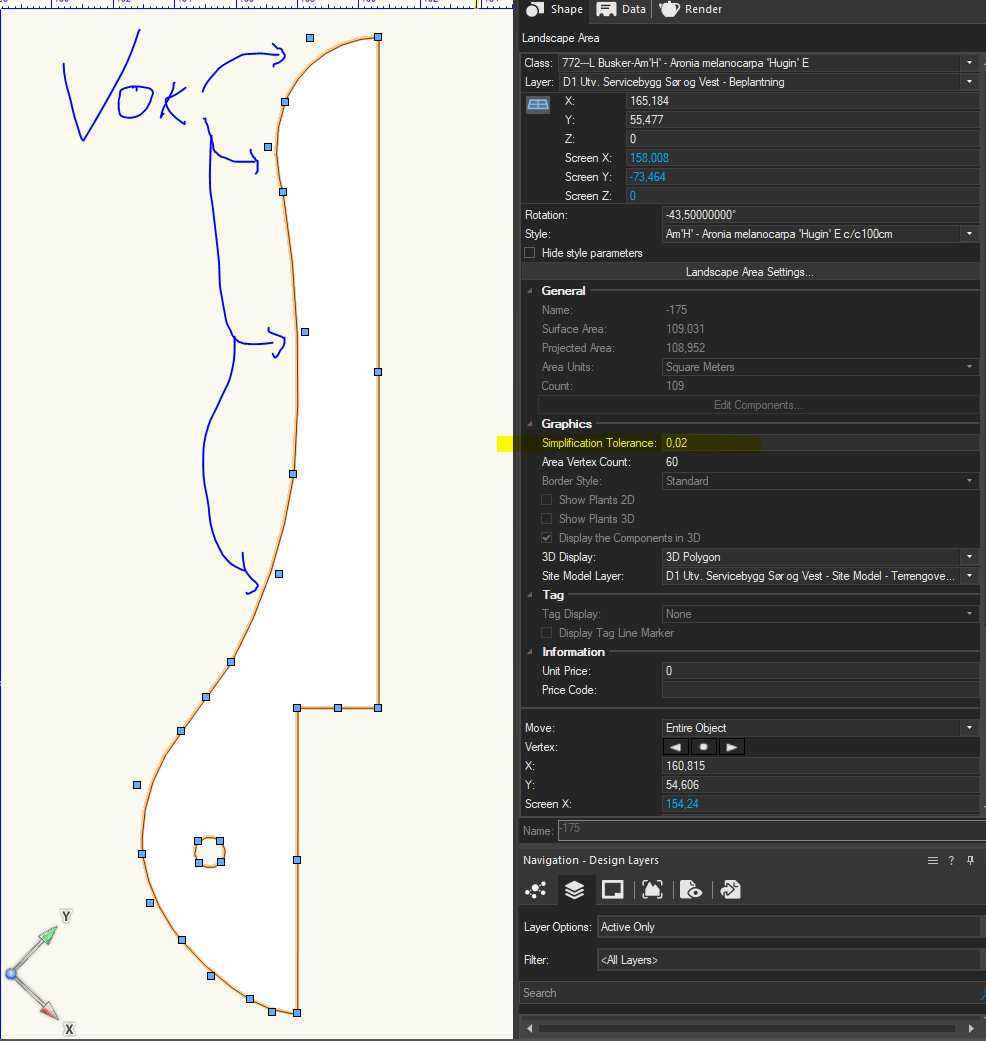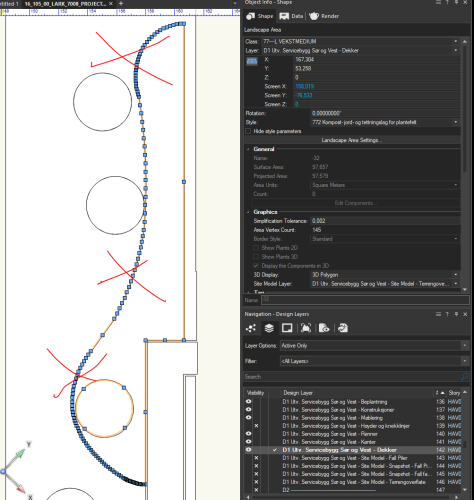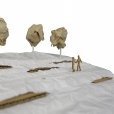All Activity
- Past hour
-
morphld joined the community
-
Apple macOS 14 Sonoma Compatibility - Feedback
Jeff Prince replied to JuanP's topic in News You Need
I’m glad I’m not in the software business 🙂 -
Mac OS Sonoma 14.4.1 makes VW2024 unusable
jdlang19 replied to astephens's question in Troubleshooting
It sounds like there are various problems with MacOS 14.4.1, but the particular problem on our end (computer rebooting when toggling into Vectorworks) seems to have gone away by having Vectorworks live in its own workspace (or "desktop"). Might be worth a try for others. Basically we are running Vectorworks in Desktop 2 and every other application in Desktop 1. -
I have to disagree with a lot of this. Not all curved landscapes must be made from arcs with radii, it’s perfectly acceptable to use curves like beziers and such if your contractor knows how to build them. Is the “problem” you are experiencing with importing AutoCAD splines and arcs into Vectorworks due to bad import settings or perhaps poorly drawn AutoCAD? I don’t have these problems with well made AutoCAD files, but I used AutoCAD for 20 years, so I know how it works. What makes “bad” geo inside AutoCAD? Drawing without tangency…not using snaps…Offsetting splines to create parallel edges… as it turns out, a lot of the same bad practices people have in Vectorworks. Understanding geometric construction, especially with complex curves, is a dying skill. It’s easy for people to blame their softwares, it takes experience and craftsmanship to make things… even in the digital world.
-
I see your point, Jeff, and generally agree. In fact, I have a 2008 MacPro with twin Xenon processors running OS10.6.8. I maxed out the ram, installed an SSD, and upgraded the video card. This machine and OS are, in my opinion, the most robust Apple has produced. It is, as you say, frozen in time for the sole purpose of running Logic 9 music creation software. It works amazingly well and I would never expect any modern software to run on it. But I feel this is different and I'm actually not looking at what is best for the VW users. I'm looking at what is best for Vectorworks as a company. In all cases like this, the question is where to draw the line. I feel that updating an OS to the next version does not meet the standard of a wreckless action. It is actually promoted by both Apple (or Windows) that you should upgrade. Vectorworks does the same. It's not like the users of 2022 are jumping three or four OS versions and expecting it to work. It would be different, for example, if I expected the 2024 version of Logic to run on my 2008 MacPro. So, I'm suggesting drawing the line at five years for a perpetual license. Not only would that fulfill their promise of software that will work for a reasonable term, but I also think it is very beneficial to Vectorworks to show this level of support for its users. It is a very small price to pay and a great opportunity for VW to show it cares about its user base--and building it. I admit companies rarely think about goodwill being a positive business decision. But they should. Vectorworks has a tiny user base. This is an easy way to help build it. MH Brown
-
Exporting to Old Version without Access to New Version
campincem replied to EmilyArch's question in Troubleshooting
Hi! Could anyone save this file created with 2023 in a 2021 version? Thanks you in advance! Rylevang 3B · D 056 · A 7.10 · Oversigt · Skabe.vwx -
Adam LR joined the community
- Today
-
Apple macOS 14 Sonoma Compatibility - Feedback
Jeff Prince replied to JuanP's topic in News You Need
That’s a hard position for me to support, especially in the technology space. If I were electing to stay on a previous release in perpetuity, the prudent thing to do is to maintain that vintage of hardware and OS in perpetuity as well. The user has the choice here and if they want fancy new OS features, they should upgrade their other softwares accordingly. I have not upgraded to Sonoma yet because I like my software to work 🙂 I don’t understand why people feel compelled to run the latest of everything and then expect it all to work…. New Release = Beta Tester in the software world. -
I assume that those persons using VW2022 purchased a perpetual license, otherwise you would simply upgrade to VW2023 or VW2024, yes? Assuming that is the case, the reasonable--and I feel honorable--thing for VW to do is send a perpetual version of VW2024 to those users. That is the thing about this word "perpetual." Having worked in and for museums most of my career, I can tell you that an accessioned object at a museum is generally accepted with terms that the institution care for the object "in perpetuity." But neither side can predict the future. There may be fires, floods, political unrest, or uncontrolled third parties who change their software in unpredictable ways. And regardless of the calamity, a reputable museum will do everything possible to secure its collection. The reputation of the institution is, in many ways, established in how it reacts to these types of unpredictable events that test it. How do they measure up? Reputation is not only an important thing, it is the ONLY thing that matters. It can be lost in an instant, but take decades to recover--if ever. VW might want to think about that as it considers its options regarding the non-working 2022 perpetual licenses out there. It sounds like neither party is at fault, so what to do? So, here is what I would suggest to Vectorworks: Live up to your promise of delivering a "perpetual" product. Give users of perpetual 2020 through 2022 versions that do not work under Sonoma, a perpetual version of VW2024. Even though it's not your fault, you should live up to your bargain of "perpetual" regardless. This may not mean forever, but, really, I think a reasonable person would say two years is far too short of a term for a software to work. I'd say something more like five years, but whatever it is, put it in writing. Just my opinion. MH Brown
-
All geometry that Landscape architects works with that is to be built should use curves with whole numbers of radius. No curves shall be divided into lines. The problem arises especially in our company when geometry is imported from other software such as dwg. All curves are then divided into countless lines, which is useless and makes the model very difficult to work with. When this happens, I ask those responsible to re-model the geometry in Vectorworks so that all curves and arcs have geometry that can be adjusted and changed. All arcs then only consist of three points, start, middle and end. This is where it is important to further control geometry with Simplification Tolerance. The first image shows geometry that is correct, while image 2 shows precisely the problem that the geometry has come from AutoCAD 2D. Sloppiness and inaccuracies that have worked for drawing production in 2D do not work when we work in 3D and BIM. Geometry must therefore be modeled again or changed so that all curves get the correct shape. Why should we allow mistakes to continue in the first place? 3D and BIM are also helpful in making us more precise and accurate.
-

nurbscurve line can't change in a dashline?
VIRTUALENVIRONS replied to filip's topic in Architecture
-
Vectorworks 2024 Update 4 Available for Download - UPDATE 4.1
Stig Runar commented on JuanP's article in Tech Bulletins
Where can I choose between bucket and progressive mode on Redshift rendering? -

EAP, Multiple Planes, Radiused Corners
VIRTUALENVIRONS replied to Ed Wachter's topic in General Discussion
If you could post an example that "can't, it would be helpful. -
Jona Muser joined the community
-
Very nice workflow @aage.langedrag! I am still wondering why there is a conversion with the geometry from the simple original shapes that can have very few vertices, to the polygons with many vertices used with Hardscape/Landscape areas/3D geometry. Doesn't this make revisions to the geometry of these areas very time consuming?
-
dear users, does anyone know how to change the grafics of a nurbscurve? Filip Bosscher
-
You can have a data tag that reports the today's date. Then you can use the DataTagField function with a criteria defined to get the value from the data tag. But you will still have to reset the data tag (for example by moving it) to get the date to update I think.
- 1 reply
-
- worksheet
- title block sheet data
-
(and 2 more)
Tagged with:
-
Finished setting in VW2024 is probably 0.025. Setting is absolutely essential for the large model in VW to work and not collapse. After much use of this method in my models, I have used this general rule. 0.02 or now 0.025 - Early stage and standard. Then I work in more detail on how you want the object structure to be in the IFC for construction. NB. You have to work your way back and forth with some objects that have complicated geometry in order for the object to display correctly in 3D. Some solid objects in VW sometimes lose 3D geometry and then it helps to change the Simplification tolerance. Thin edges with rough settings mean that the outer and inner side of a curved edge suddenly have overlapping and intersecting geometry, which then becomes incorrect. Therefore, you sometimes have to go down 0.002 on certain objects while the rest can be 0.02. You also need to use setting to let geometry which is important to get right in IFC for build to model, edging of steel, get 0.002 while plant field which only specifies a 3D volume with plants has got 0.02. Very frustrating is that every time you have made changes to a landscape area, the setting is reset to 0. Completely unnecessary, unfortunately, so you have to make the changes again. I have built-in control views that color all objects after setting the simplification tolerance. All objects that have this =0 are red. This helps me quickly spot problems before I export IFC. Large models cannot change many objects at once. You must then select one volume at a time to change. If you have sent the landscape area to a site model that is on different design layers, a new problem. Then you must remember to have the Site model visible before you start making changes to the landscape area, otherwise the object will lose its height and lie down at sea level.
-
Flora C joined the community
-

Multi-storey building all in one storey - would this work?
line-weight replied to line-weight's topic in Architecture
I'd say I just add levels to the storey - layers don't come into it really. My levels and layers are independent of each other, other than that the layers have to be associated with the storey in order to have access to the levels. However I'm aware that I'm not exactly using it as intended because I am ignoring most of the functionality that is to do with having multiple storeys and level types that occur in several of them. I don't quite understand how a Level is associated with a Layer (via that "Create Layer" check box you mention) or what exactly that means. I may have managed to understand it when I first figured it all out. At the moment though I don't need to understand it because my system works fine for me for now. I'm not surprised that many people don't use Storeys at all. The whole setup is very confusing. The way the various interfaces are designed doesn't help. I think in the explanation of how it works, there needs to be some kind of graphical representation of how everything (that is, layers, storeys, levels, level types, layerless levels, etc etc) relates to everything else. -
Hello, Is there a way to show today's date in worksheet cell with spreadsheet setup? We are using this functions: =FORMATFIELD('Title Block Project Data'; '...') to get some data from title block border ... but would be great if we could add today's date too .... to the header of the worksheet layout with list of drawings (database part) as a main part of worksheet. I guess it doesn't have to be connected to title block border data, but all we need to get today's date displayed + so that it automatically updates to correct date. Any help much appreciated.
- 1 reply
-
- worksheet
- title block sheet data
-
(and 2 more)
Tagged with:
-
If you change to .001, doesn't that give you a huge number of vertices?
-
Alt + 0176 on a numeric keypad apparently...
-
Thanks a lot! You're a mastermind - really! I never came through the idea to choose the basic criteria (of e.g. Channel - 3D) for a dummy report... But it makes sense. Even the result looks strange... This dummy-worksheet lists both types of Series: AISC (inch) and DIN (Taperd Flange) although the profiles I used are all DIN. For Size it's more confusing - 8 sizes are listed: '__size_8' is the one I used (U60) but for example '__size_6' gives 150 x 75 x 18 what is completely wrong. That looks more than a try-and-error-thing (at least for me). At the end I'll find out what is necessary - even it consumes more time than expected - so what's wrong (if any)? one last (???) question: I have different parts of the construction and the record formats are all the same - just with different names (Rack, Frame, Box etc). I made one worksheet for one part of the construction with all the fields the manufacturer needs to know. For example - in the worksheet the formula ='Rack'.'Part' gives the result for all other columns too. Copying the worksheet and change the formula to ='Frame'.'Part' gives no result at all. So I guess there is more 'content' in the worksheet that I can't see, right? cu 😉 Peter
-
A_Tak joined the community
-

Multi-storey building all in one storey - would this work?
Tom W. replied to line-weight's topic in Architecture
Thanks @line-weight. I think it's just the rather convoluted way that VW has designed Stories to work: first you create custom level 'types', then you use these to create your Default Story Levels, then you are finally in a position to put your Story/Stories together by selecting which Default Story Levels you want to include. When you create a new Default Story Level you have the option to associate a Layer with it (see 'Create Layer' check box). Or you can edit an existing Default Story Level + create a layer for it after the fact. It's as if you can come at it (structuring the file) from the Story side of things where the Levels have primacy + Layers are added as part of the level-creation process as + when you need them, or you can come at it from the Layer side + add Levels to the Layers which I think is what you are doing. I have kind of done a mish-mash of both. I like the fact that I can have a Design Layer for (for example) all my furniture, kitchen units, etc + link that layer to a Story in the way that you do + then have access to multiple Levels set to the different floor finish elevations (if I have different thickness floor finishes in different rooms). So I can have all my objects on the same Design Layer but (because they are all symbols) set their elevations in the OIP based on the room they are in + the corresponding Level. Previously I used to set up different Design Layers with different layer elevations + place the objects on the relevant layers. By associating the levels to the Design Layer I can keep the layer + the levels separate i.e. I can have an 'objects' layer + 'laminate floor', 'floor tiles', 'carpet', etc levels. I don't want 'laminate floor' or 'floor tiles' design layers which is what I'd end up with if I created the layer in the Stories set-up. I've probably got all this completely wrong but that's how it looks to me at the moment! I wondered about this too. -
- It is currently working when it is active as the TBB gets reset to update the Total Number of Sheets and Page Number fields. The side effect of this is that the Sheet Number and Title get updated too.
-
What happens when it doesn't work? Do you get an error message? I can't get it to fail. Unless it's two 3D Polys instead of one. I'd probably draw the path as a NURBS Curve (Curve Degree 1) rather than a 3D Poly.
-
EAP, Multiple Planes, Radiused Corners
Ed Wachter replied to Ed Wachter's topic in General Discussion
Fun video! Not to mention informative! Thanks, Ed








